What would you do if you knew you’d die at 45?
Would you continue working hard in your job which pays peanuts?
What if your job is the reason you’d die at 45?
What if… there are no other options?
This is the fate of the 12 000 miners of Cerro Rico (Rich Hill) in Potosi, Bolivia. And I had the chance to visit these miners on a tour to the mines.
(Once) The World’s Richest City
At 4090m, the UNESCO declared Potosi is the world’s highest major city and houses the once-largest silver mine in the world, Cerro Rico.
Due to the discovery of the mine, economy boomed in Potosi in the 17th century, and at one point, was one of the world’s richest city. The wealth and grandeur of the city can still be seen with the old churches and grand architecture near the main plaza.
“I am rich Potosi, treasure of the world, king of all mountains and envy of kings”
With wealth, came the conquerors. The Spanish exploited the mines, and the silver ran out. Spain became one of the most powerful country, and Potosi?
Well…
Today, Potosi is the capital of the poorest department of South America’s poorest country.
The Miner’s Market
I booked a tour at my hostel the very night I arrived at Potosi, and got picked up by the guide the next morning. The bus brought us to the Miner’s Market, a place where the miners buy their tools of the trade and supplies like coca leaves, alcohol, cigarettes and dynamites.
Yes, dynamites. The Miner’s Market is probably the only place where you can legally buy dynamites over the counter, and they are used to blast new tunnels in the increasingly hollowed-out Cerro Rico.
It wasn’t written in the tour brochure but we were expected to buy ‘gifts’ for the miners. These gifts are meant to help the miners, or maybe, to alleviate our guilt for visiting distracting the miners while they’re working.
Coca leaves are well known in the Andean region to help with altitude sickness, appetite suppression and boosts in energy. I had my fair share of coca tea and similar herbs in San Pedro de Atacama. The miners chew coca leaves religiously in and out of the mines and are often seen with a huge lump in their cheeks.
- YOU MIGHT ALSO LIKE: Coca Tea! Every morning on the Salkantay Trek!
The miners also drink 96% alcohol during their break time and smoke cheap cigarettes. As if the darkness, narrow tunnels and inhaling sulphur, arsenic and other cancer-causing particles isn’t harmful enough, they also smoke tobacco and drink almost pure alcohol.
Each of us bought a pack of coca leaves and orange juice for the miners (no harmful substances), and a face mask for ourselves.
We went to a small staging area inside a ramshackle building and put on oversized protective gear, plastic helmet, headlamps and rubber boots. It’s funny how everyone else started taking photos like it’s their OOTD.
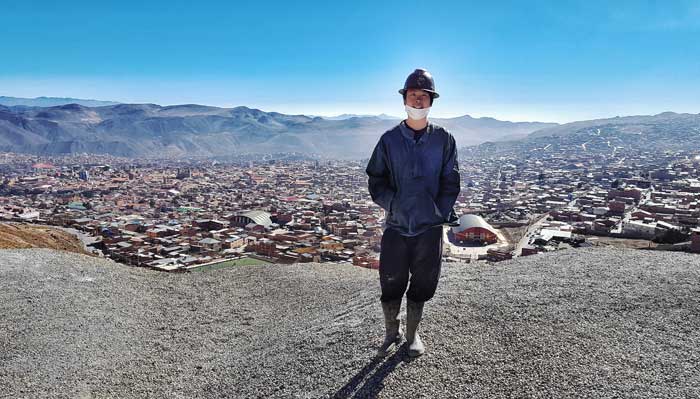
Here is also where you should use the bathroom because it would be a few hours later in the mines without any opportunity. Or you can do it “Bolivian style”, like what a German tourist in my group said when urinating in the mines.
Cerro Rico Mine Tour
The outside of the mines looked like an abandoned dumpster: Old mining carts laid everywhere, garbage littered on the grounds, and many small buildings hastily assembled to store the miner’s belongings. It was dirty, smelly and had the winds whipped up clouds of dust.
We formed a single-file and entered the waterlogged entrance, following the narrow wagon tracks into the blackness. Just 5min in, the ceilings went low and we hunched down as low as possible.
Before entering, our guide warned us to look up, not down. “Tock! Tock! Tock!” We took turns to knock our heads against the low hanging wooden crossbeam. That’s what happens when you look down.
Thank god for the helmets, otherwise I’d be gushing blood from my head. “Sorry, the mines were made for Bolivian people,” said our 150m tall lady guide.
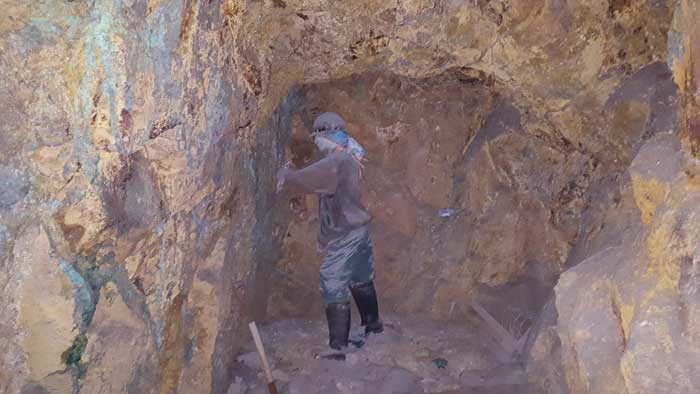
The ceilings alternated between low and high, and each time we straightened our bodies, it was a brief respite. Who knew it would feel so good to be walking normally?
The mines were dark and damp, lit only by our headlamps. “The water in the ground is natural,” explained our guide, “It came from the mountains. Cerro Rico used to be a volcano.”
The miners work in groups of 4 or 5, and each time we passed them, we stopped for a chat and handed them our gifts. They were appreciative of our gifts and seemed as inquisitive as us. They got to know where we came from, and we got to know that some of them started work at 4am that day.
“We eat the Mountain… and the Mountain eats us.”
Cerro Rico is known as the “mountain that eats men”. More than 8 million people were estimated to have died working in the mines since the 16th century. The Spanish used slave labour to extract tons of silver, with miners living in the mines up to 6 months at a time.
“For the powerful emperor, for the wise king, this loft mountain of silver could conquer the world.”
Working conditions in the mines have not changed much for the past 500 years. In some parts, hastily-assembled wood braces held the walls and ceilings together. In other parts, the ground is waterlogged.
Steel carts full of ores run through the narrow tracks all the time and whoever is unfortunate to be standing in its way, well...medical aid is not readily available. The excessive use of dynamites turned this 4824m high hill into a giant ant hill and declared a hazardous area due to its hollowed structure and imminent danger of collapsing into itself.
What they earn depends on what they find and also on the international market. Many of them do not work for private companies but in cooperatives. A large part of what they earn are used to buy their own equipment and supplies and because of this lack of resources, they mine in old fashioned ways like using pick axes and dynamites instead of drills.
Even when they survive accidents and cave-ins, the miners are at risks for Silicosis and other respiratory illnesses. Many miners die at 45-50 years old. They are trading a hope of an income twice the minimum wage for a reduced life expectancy, and they know this.
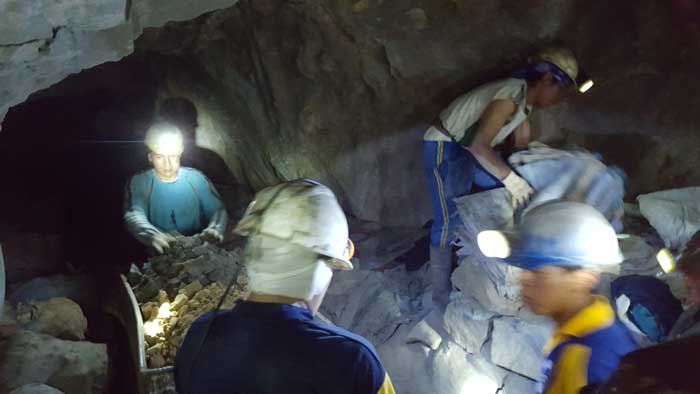
It is a world of difference to hear about the atrocious conditions the miners work in and to actually be there to experience it for yourself, to be in the alien environment, to inhale the mineral dust.
“Put on your face masks,” warned our guide. We coughed and the throats burned as we walked past a sulphur-filled section. The face masks were useless for the dust particles.
Near the end of our tunnel was a ‘museum’. Inside were 2 statues of the Devil, El Tio. These mostly Catholic miners believe in a God above ground, but when inside the mountain, El Tio rules them all.
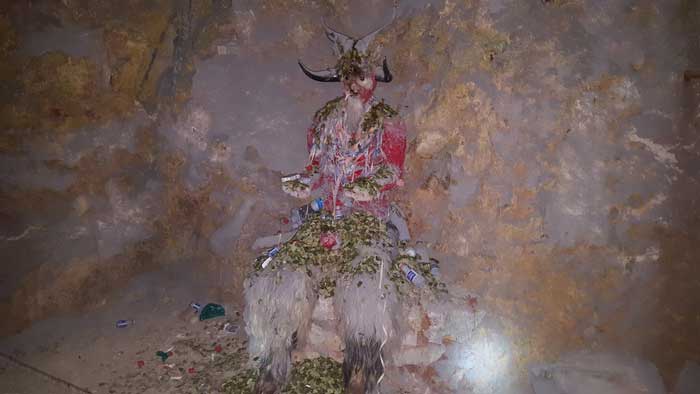
The miners believe that if you do something to upset or anger El Tio, you get killed in ‘accidents’ such as cave-ins. On the other hand, if you make him happy, he’ll reward you with big discoveries of minerals.
How?
The coca leaves, alcohol and cigarettes are given as offerings to appease the Devil himself. Our guide demonstrated by lighting a cigarette and placing into his mouth, pouring coca leaves over the body, and pouring the 96% alcohol; once on both shoulders and both knees, for the 4 directions in the mines, and once on his penis for fertility. “Pure alcohol for pure deposit,” she said.
“Why are there two statues?” I asked.
One was from the colonial period, and one is the modern version – as can be seen from his modern boots.
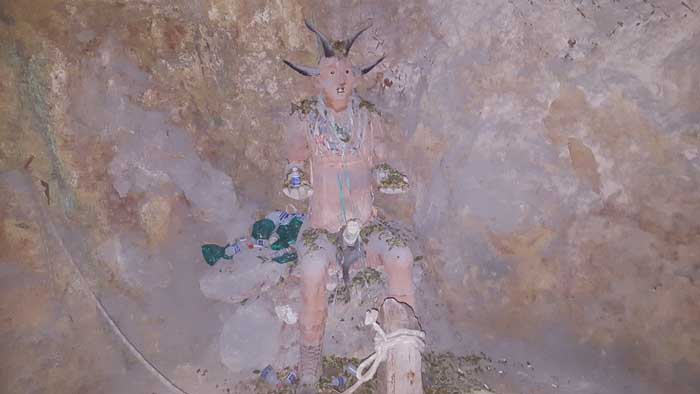
Each of us took a sip of the alcohol, followed by a macho “ahhh”, like how David Beckham does it in the Pepsi ads. Miners like to be seen as masculine.
At this point, almost two hours in, some of the tourists couldn’t take it anymore and wanted to leave. The narrow tunnels, low ceilings, mineral dusts was starting to take its toll on us. This is definitely not for the claustrophobic.
We made our way back towards the exit – the proverbial light at the end of the tunnel – and felt like a caged bird spreading its wings.
It was only 2 hours but I was ready to leave. I can’t even comprehend how these miners work 10 or 12 hours a day, 6 days a week. I don’t know how they do it but I have the utmost respect for these guys.
(Coincidentally, I met an ex-miner in Sucre and was invited to celebrate his 60th birthday with him and his family.)
Humbled
Some people question the ethics of such tours - linking it to a human zoo – and I can see where they come from. Personally, I was glad that I went for it because it was such an educational and humbling experience. Besides being aware that such working conditions still exist, something stirred inside me.
That very night, when I was dining at a local restaurant, a little boy of my nephew’s age – probably 9 or 10 – came in. He played some music and sang with his heart, then went around asking for money. The locals gave him their loose change but I passed him a note. It wasn’t much to us, but it was enough for him to get a meal. I could see his gratitude as he thanked me and left, spirits a little higher.
When I was walking back to my hostel, another kid was sitting by the streets – in the winter cold – playing drums and singing for money. I gave him my drink and he took it hastily.
I can’t change the world but I hope that these boys can at least retire early that night. Given that mining is the heart of the economy of the city, they will probably end up being miners and have the same fate as those before them.
After that night, I was determined to improve my Spanish to connect better with the locals. I enrolled in a Spanish school in Sucre and plan to do some volunteer work, no matter how little difference I could make. I texted my mum and she gave me her blessings.
Tours like this certainly put one’s working conditions/life into perspective and I encourage everyone to give it a go (as long as you’re physically fit and not claustrophobic).
And now, it’s your turn.

